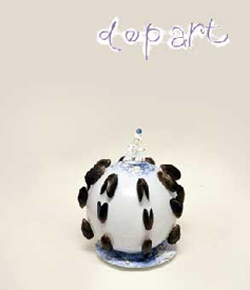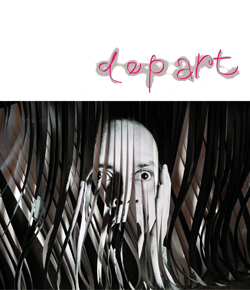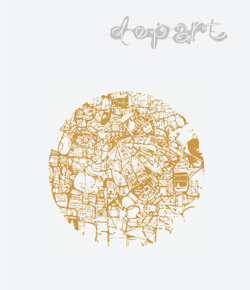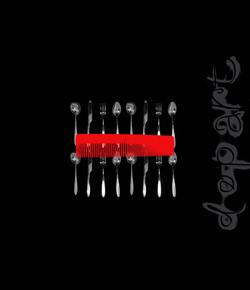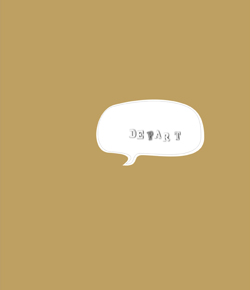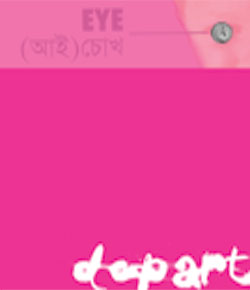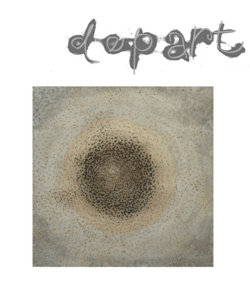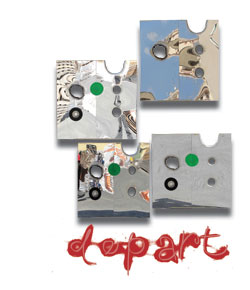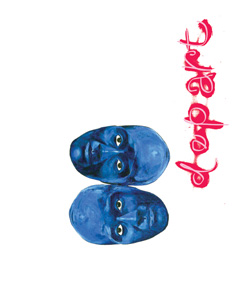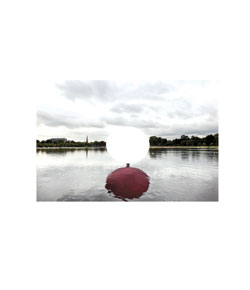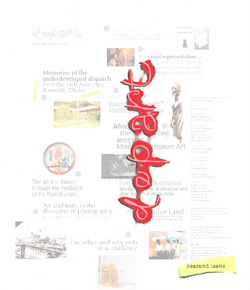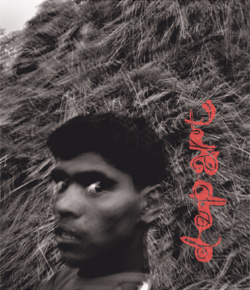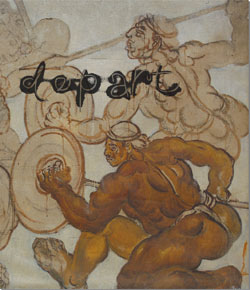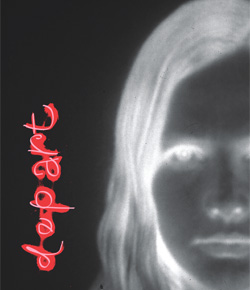Features
The perimeters of Abstraction
Works from the centre, periphery and other extra-terrestrial locations
Following its emergence as a pictorial device, abstraction seemed as if it always lurked behind some form of art or another. That it had to be rescued from its state of obscurity so that its true nature be seen, articulated in its singularity of character, had only occurred to the Europeans. Recasting the relationship of the artist with the external world by voiding the pictorial space of all traces of references, abstraction, during the second half of the 20th century, penetrated the societies across Asia creating what we may refer to as a second wave. The following article examines the impact of such reductionism of the European and American origin on the art scene of Bangladesh.
The temperate and the formal

Proliferating as vernacular metropolitanism, abstraction in the 1960s Dhaka was mostly about the interiorized/localized, and even to a degree, formalized strictures of a mode of non-representative art whose analogues are to be found in the outputs of the European Informal Art and the New York school of AbEx (Abstract Expressionism). Overlooking the imperialist subtext of the very concept of 'Internationalism', an upshot of the 'Enlightenment, with its universal context-free reason', a band of artists as part of their strategy to depart from the usual brew of Indigenist Modernism of the earlier generation, boldly borrowed what has been left for them to borrow in the context of all the borrowings that were going on in the name of catholicism in art.
Though they utterly failed in highlighting the interstices of the Modernist Doxa and the homosociality dreamt up by the contesting political forces of their time, as exponents of Dhaka abstraction they chose a path which had already been paved to some extent by their previous generation, those who had showed competence in conflating Western academism with the Cubist conceit of shattering the picture plain into fragments. In fact, before venturing into abstraction, every piece of Dhaka's soon-to-become AbExers represented subject matters in an encrypted visual code, resulting from an experiment that made the image look cobwebby, a signature trapping of Cubist origin, the parallel of which could easily be drawn in the phenomenal success in splintering the atom.

The moot question around 1960s art scene: is formalism of this variant linked to what Syed Ali Ahsan once referred to as 'formatized intelligence'? If so, how this band of art students from the 1st and 2nd batch of the institute Zainul Abedin had brought into shape in 1948 with the help of his colleagues, after passing out, developed the knowledge to renegotiate modernism according to their will and ability while taking a bold stab at the contemporary techniques? The widely accepted fact is that the knowledge web that New York AbEx was part of, had never made its way into the art scene of Dhaka, where the traces of the visual language emerged to fuel a movement, which had, since the very beginning, lacked the intellectual underpinning any such movement usually demands.
In tracing how the logic of EbEx, which penetrated the young minds of Dhaka's fledgling art scene in the 1960s, we can make effort to situate its virtual laboratory in the consciousness of the alienated 'modern subject', whose art is a way for him to rediscover the displaced self? Or, after re-examining the efforts, should one conclude that it is just a trapping for the 'modern subject' who confuses the Exterior World, where he confronts a trend of global appeal and shows immediate allegiance to it, with the Interior World, which is the projection of his own individual interpretation of the world and his undernourished, attenuated self. Surely, the wholesale separation of the interior and the exterior worlds, which yields to such confusion, is what pushes the individual, alienated as he is, towards a subordinated status vis-à-vis the dominant narrative of his time.

For the European migrant artists who managed to take the extrinsically-defined experimentation to an irrational height while stationed in New York, art provided the frame to look beyond the dystopia that the grids of power and politics of that particular city was bound to produce. For Jackson Pollack and even for Mark Rothko, artistic process was open-ended and was clearly an invocation of the primal spirit – an effort in reclaiming the archaeological remnant of the mind, where the primitive consciousness occupies a niche, which has been circumscribed by, if not totally lost to, scieniticism, reasoning and hyper-materialistic living. The fact which needs to be pinpointed here is that Rothko was an avid reader of Nietzsche, and always tried, in his own word, to reconcile the Dionysian with the Apollonian spirit throughout his career, exemplifying the jump that he wanted to make from the 'phenomenal' to the 'numinous', or to put another way – to represent the unrepresentable – 'nature', 'the sublime'. There is a pause here – a space for revising our reading, as we know that the numinous in the AbEx domain is only an inverted numinous. John Rajchman strikes the right cord when he says, in the Journal of Philosophy and the Visual Arts, No 5, that, '[a]bstract is what is not figurative, not narrative, not illusionist, not literary and so on, to the point where one arrives at a sanctifying negative theology in which “art” (or “painting”) take the place of “God” as That to which no predicate is ever adequate, and can only be attained via the via negativa.'
In contrast, Dhaka art scene seemed like an 'enculturation project', devoid of any such psychosis or inverted metaphysics; here, through the emergence of a new generation in the 1960s, some similar as well as innocuous looking paintings symbolized urbanity while they were made to resonate with its cognoscenti's anodyne projection of a world view based on the traces of European classicist ethos and the spirit of Enlightenment seeped into the system through Rabindranath Tagore's literary and cultural inheritance which undoubtedly had a sobering, neutralizing effect on the minds.

The literary puritanism of Tagore percolated into the optical puritanism of abstraction. As a result, the baffling tautology of Dhaka abstraction doesn't seems too baffling to the educated eyes, as one is able to connect the producers' scopophilic tendency to the appreciators' truncated and chiselled life/world view where class and power politics remain smothered by a set of sanguine (pseudo)narratives. As such, the idea of chivalry on the part of the artist who assumes the role of the painter-hero often seems to degenerate into painter-appropriator; and the 'freedom' enshrined in the expression of the 'act of creativity itself' has been thoroughly diluted by the act of submission – both to the concept of 'internationalism' and by catering to the taste of an 'exclusive urban minority' with links to cultural hegemony and power.
Suppression of the terrifying (Unerfreuliches) and the unaccountable (Unzuberechnendes), about which Goethe reflects in a tract on the subject of chronotropic (time and a turn) effect, is what makes the Dhaka AbExers look like as if they were producing structure (or social etiquette) rather than contesting it to address the tide of the time. One should bear in mind that their 'etiquette art', in retrospect, would have found an equivalent in the Greek theatre of the antiquity had Socrates' prescription been taken seriously. The philosopher vehemently espoused that Greek dramas be scoured clean off the traces of the primordial remnants which antagonize its otherwise rational structure so that it resonated with the reasoning minds of the responsible citizenry.


The artists who either wanted to depart from the temperate abstraction of the 1960s, or gave it a new spin, were Kalidas Karmakar and Abdus Sattar, the former being a versatile manipulator of form and a dexterous exploiter of extraneous materials. Kalidas came up with images that seemed to have thrown the static diagrams of Yoga, fit for the meditative gaze, into the whirlpool of time and temporality, lending abstraction its most innovative and hybridized face.
Both Kali and Sattar emerged in the 1970s and successfully toggled between figuration and abstraction, though their present preoccupation veers towards a marketable art putting a question mark over how relevant the work of their later phase will remain in the years to come.

Although muted in articulation and often hinged on the 'machine finish' look, Sattar's works, his woodcut pieces of the early 1980s in particular, bespeak the creator's attentiveness to the formal distribution of space and elements onto that space, achieved only by setting aside the scenographic model that engages more with surface to make it look expressive than with shapes and forms.
There were other artists who emerged with or without being informed by the anxiety the issue of contestation and conformity with the dominant trend often precipitated the art world into. Among them were two of the most visible exponents: Naima Haque, and Kazi Ghyasuddin, both appearing on the scene in the 1970s to form its two poles – the former, reticent and restrained in her presence, and the latter, aggressive and obdurate.
The most active exponents of the genre, who has been exhaustively staging his imagery throughout the 1980s and -90s, is Kazi Ghiyasuddin, whose language of abstraction hinges on a technical finesse which, in turn, has underlined his success (from the commercial point of view) at home and in Japan. Though, quite often, due to their predetermined and exact executional process, his works are made to reach a reified end as the emotional content is often replaced by his technical aptness. The slightly loose diction he sometimes cultivated brought into view weathered surfaces, a much appreciated line of production.


However, the most interesting interpretation of such textured/weathered surfaces came form the younger generation artists such as Mohammad Eunus, and Tarun Ghosh, emerging respectively in the early1980s and the later part of the 1980s. If the former had eschewed all kinds of narrative/discursive inheritance, the latter tried, throughout the 1990s, to incorporate in his domain fragments from rural lore as a kind of symbolic homage to them, mostly accentuating the subaltern myths such as Behula and Lakhshindar.
Though mute, and astringent in expression, Naima Haque's mixed media works bring into play a feminine fervour that remains at a comfortable distance from identity politics as the primacy of subtleness of the material in use was her apparent goal. Often resorting to cheap newsprint paper, which, in her oeuvre of the 1990s, appeared as scraps pasted on white paper sparsely treated with pencil and ink, her pictorial conceit rarely ventured in the direction of the grandeur that the early abstractionist thrived on.

In retrospect, it seems an important task to try and cluster artists given to abstract tendency under various registers highlighting the differences that emerged through their works. The symptoms of such differences appeared in figurative, conceptual and other non-abstract laguages and also from within the canon of the formalist mode of expressivity. Notwithstanding the influence of the early abstractionists, the art scene has only been thoroughly shaken by the rise of some new tendencies of the new breed of artists. Concurrently, from within the bastion of abstraction, the emergence of some passionate individuals who are disinclined to cast their language in the tradition that has seen the collapse of painted surface into the bare minimum, they devised detours from the usual formulaic process, giving rise to some new physiognomies of an old art form. Among these artists there are ones whose passion seems volcanic in proportion, and a few who show temperateness to the degree of Kibria without emulating the painter's tactile quality, which has become the defining glory of Dhaka abstraction.
Though new sensibilities appeared only at intervals causing rupture to the repetitive ritual which was the preoccupation of the most abstractionists, since the emergence of the first batch of abstractionists – Kibria and Aminul Islam et al, the art scene remained glued to a few fixed models of representation. Both artists exerted considerable influence on the mainstream as abstraction's most revered alchemists. The only occasions for interruptions were devised, intentionally or unintentionally, by artist like Kali Das, both as painter and etcher; he seemed to have held in check the normative gaze that rules over the cultural landscape by inscribing his work surface with certain religious symbols and/or effectuating a busy pictorial drama with restless composition and indefinable elements.

Aligning with the first generation of abstractionists were artists who, with their appreciation of the conventional surface painting, produced mostly medium-specific painting and graphic works. Among them there are some established names and a few peripheral personalities: Abu Taher, Syed Jahangir, Mahmudul Haq, Abul Barq Alvi from the generation of 1960s, and A K M Alamgir, Mominul Reza, Mokhlesur Rahman, Hasan Mahmud et al.
Sensual indulgence in the works of the young breeds
To gaze upon the sky is to reflect upon the infinite. With the rare exception of astronauts, one engages with the sky from one's position on the ground. Even when searching the cosmos with the mightiest telescope, one is invariably limited by one's earthbound position. How, then, to separate the big sky from little Earth? It can't be done, for our appreciation of the one necessitates our consciousness of the other.
– Scott McLeod, editor, Prefix Photo, Issue 24, 2011.

'Creative people in the sciences as well as the arts would often remark that their processes of creativity included moments in which the flow of images or ideas or words came as if from some source which seemed other than the creators themselves (Jung, 1970, p15). Part of the creative act seemed to involve simply being receptive to what the ancients called “the muses,”' concludes Adam Blantner, professor, department of Psychiatry, University of Louisville School of Medicine, in an academic paper.

The cognitive-emotional-imaginal patterns of the mind – to which Jung assigns cardinal value, give rise to the condition of being mimetic, and this is exactly the province from where the sentient or sensitized body starts to attempt its transcendental act which is creation of the other. Perhaps it is through mimesis, not interiorization, that most artists reach to the level of personalized logic of operation. If the 1960s EbExers of Dhaka had failed, in many counts, including in refiguring a borrowed language by creating an analogue to the American archetypal act of responsiveness inaugurated by Rothko, Pollack, De Kooning et al, Dhaka had to wait till the 1990s for the emergence of some emotionally inclined artists who would be considered as successful progenitors of an art that enshrines the emotive alongside the rational through a performative engagement with the picture plain. The manifestation of what Paul Recaur calls 'graspable expression of an inner operation' could only be made possible when means applied could yield to an intense form of expressivity marked by both sensuous and extra-sensuous qualities.
Mohammad Fokhrul Islam and A Rahman are the two hyperactive exponents of Dhaka abstraction, artists who gave a new lease of life to the genre. Through the hands of these young artists, painting as a process was born in this clime. Simultaneously, their works articulated a strong thrust towards other ends, among which a desire to invoke nature was an important destination. This dovetailing of the concept of art as a creative process with its effectiveness as a vehicle to begin a parlay with nature, also gave rise to other artistic registers. The emergence of the autodidact Sallahuddin Ahmed, whose early landscapes almost defused into abstraction, complemented the works of other artists. By way of providing an antidote to the anodyne abstraction which has been slowly encroaching on the consciousness of the urban elite, Sallahuddin impassionedly brought forth the idea of loss of nature as well as wilderness in the simplest idiom possible addressing Dhaka's deteriorating urban conditions.

From a procesal point of view, in the late 1990s, Wakilur Rahman, an expatriate living in Berlin since 1989, and Rashid Amin, who has divided his time between Dhaka and Beijing since the early 1980s, came up with imagery which also encapsulated the unbound spirit of nature. These were artists whose relatively controlled etchings proved to have lent momentum to the practice of abstraction in this clime.
Even before the entry of the above two into the Dhaka mainstream, Ahmed Nazir was able to cut a swath through the line of expressivity linked to the earlier abstractionists in the early 1990s, through what we may now dub as automatic gestures of a new performativity. His monotype using the lithography stone as base predates the performative force with which Fokhrul Islam and A Rahman would soon begin their 'actions' – only to prove that 'the body is not a “mute facticity”', to borrow Judith Butler's expression, by engaging with the picture plain as an active being rather than a thinking human. The result certainly was a departure from the static springboard (into the mode of abstraction) so skillfully devised by artists like Kibria, Aminul and Baset since the 1960s.


The ground for departure from the fixed frame through which to articulate abstraction came via myriad other practices, including what G S Kabir did to painting by employing printing techniques to dress the painted surface in a whole new garb starting from the late 1980s.
These are the artists, who, by breaching the bounds of normative practice, saved a language from falling into a rut, and among them, the artists who are relatively young of age, by their robust ambition and emotive power, created what H K Bhabha calls 'the liminal site of modern society'. The art which was just level-headed, esoteric rendition of the artists who had, at one point in their lives, responded to the impact of nature, or city walls and other micro-level surfaces achieving a tactile quality of Euro-American origin, soon became passé as the new breed began to overwrite their language. Though represented by a small number of successful artists, the new breeds took over the actual playing field. One must add to this web of facts that the sustained fiction (around the issue of its being original in its cast) of the Dhaka's fort of Old Abstractionists remained unscathed as the institutions turned a blind eye to the New Development, ensuring that these artists gained recognition at a slower pace than their counterparts from the previous generations.

As through act of their approbation, people representing the cultural mainstream in the city, constantly try and 'contemporize' an old mode of production, the New seems to remain stationed on the periphery. The fact remains, that what is new began to exert its presence not through the institutions but through individual efforts – solo exhibitions that the artists themselves organized at first at venues for fledgling artists, and later, in major galleries, ensuring their entry into the mainstream. However, the values that underline art as something that actuates 'endless arrival', and not art 'in progress', seems to be the ultimate plotter of the future of AbEx in Bnagladesh, and only few of its exponents could successfully stage again and again an alternate to the selective gaze and tautological absurdity of the past generations.
When West met East
Around 479 to 501 AD a Chinese master of art had in writing the six conons he formulated which are as follows:
1) Chi-yum Syeng-tyng = Spiritual tone and life-movement
2) Ku-fa Yeng-pi = Manner of brushwork in drawing line
3) Ying-wu Hasing = Form in its relation to objects
4) Sui-lei Fu-tsai = Choice of colour appropriate to the objects
5) Ching-yimg Wei-chih = Composition and grouping
6) Chuan-moi-hsich = The copying of classic master-pieces


It echoes what has already been discussed in not so far away land – namely India, where the principles of beauty had six nodal points for the artists to take cues from. The above treatise as well as the one from India, addresses the concrete (emotion) rather than the abstract and analytical in human cognitive faculty. It provides a structure to how within the painted space the harmony or essence of nature is to be recreated in artistic terms and experiences. In China as well as in Japan, line as a pictorial element was of prime importance. Line is what followed the contours of objects to render them according to their shapes and nature. That written script or handwriting used to be considered an art form is linked to such cultural trait that leans heavily on linearity.
Chinese writing is based on ideograms, which are not signs expressing a particular sound, rather they are graphic symbols that represent an idea or concept. Some ideograms are comprehensible only by familiarity with prior convention; others convey their meaning through pictorial resemblance to a physical object.

If Chinese art was primarily concerned with line, Europe, especially during the Renaissance, following the technical aspect of perspective was finally worked out, artists were mostly concerned with modelling, chiaroscuro – devices which lent the picture plain the illusion of depth. Europe as usual was already on the path to an analytical and intellect-driven art, one which spoke of their growing interest in objectivity.
Over thousands of years, the mainstream Europe had considered their main object the depiction of an idealized form of reality attained through mimesis. In contrast, the Chinese were concerned with pictural configurations where the echo of the physical reality is to be found with contour lines as the defining factor in the act of such rendition. Keeping the backdrop of each picture blank, the Chinese and Japanese artists always made sure that their renditions of nature were in harmony with its true character – thus ensuring that sensual world was captured in its entirety – as Whole, where the subjective position of the onlooker is one with the object of contemplation. Their aim was to effectuate a spiritual understanding of the visible world where the concern for objective representation of the appearance of the object was replaced by the desire to make the beholder become aware of the Whole that is nature.

At one point in history, during the later part of the 18th century, particularly the colour, linearity and flatness, of Eastern art influenced artists in Europe who were set to inscribe the developing modern languages with aesthetic experience which originated from outside their own locus of operation. Van Gogh, Henry Matisse – both translated the Japanese influence into their own subjective way by organizing the representational elements and the surface of the picture plain as an antithesis to naturalism/ empiricism.
Landscape painting in Europe, seems to have provided the subjective frame that began to stage a mutation of the language of representation in successive phases – and soon we would discover that artists like Kandinsky and Klee, inspired by Eastern art and philosophy, has reached the final horizon where the artwork is divested of all representational elements. Even the scientifically inclined Cezanne started out as an artist who painted landscapes accentuating forms and shapes to discount the three dimensionality of the visible world. Yet, through the same technique, he translated the three dimensionality of the visible world in geometric terms.
This pictorial conceit provided the very first springboard from which to inaugurate new plasticity – which is a departure from the mimesis or representation.
Cezanne died in 1906. Following his death a letter written to Émile Bernard has been made public, where he defends his position as a painter inclined to vewing nature through geometrical shapes such as cylinder, sphere, and cusps. Such aesthetic strategies helped bring into shape the movement called Cubism – which, at the onset, served as a way for the younger generation artists like Picasso and Braque to interrupt the conventional gaze with their interpretations of subject matters such as landscape, portraiture and still-life. Cubism has successfully brought into alignment the subjective impulse of the modern age with the sense perception of reality, thereby making possible the beginning of an art of intellectual praxis.
But other artists had different goals to reach. In the tract titled 'Concerning the Spiritual in Art' (1912), Kandinisky declares that lines in art have no duty to represent the real. The self-referential world of the pictural space is complete in itself and this he emphatically brings to fore by saying, 'All methods are sacred if they are internally necessary. All methods are sins if they are not justified by internal necessity.' So to cut off the relation with the external world Kandinisky resorted to the concept of 'internal necessity'.
The fact that he believed colour, line and form together can strategize a drama of their own without referring to the world that lies external to the work, bore down on his art. And this, he argued, only reminds one of the free flowing lava from the volcano; which, in turn, brings us closer to the unleashing of the human spirit that was Pollack, who, through his action paintings, in 1950s New York, began to overwrite the art of America.
That the body and its active participation in the process of art making will have a permanent impact on what we perceive as 'image' where the fluidity of expression is achieved, was something no one could think of before Pollack's appearance, had revitalized the pictural space, and most of all it sowed permanent dissension between formalist painting and art that is the result of performative engagement. By way of pushing the spatial-temporal boundaries, Pollack charted a cosmos defined by a new dynamics of organization where colour is an element of unrestrained velocity.
— SHAMSUL ALAM AZAD
Translation: DEPART DESK
How the East was won

It was the 14th annual art exhibition of the Indian Society of Oriental Art that had provided the first noticeable entry point to the Western modernism for the artists of this clime. The exhibition opened on 23rd December 1922, where the Bauhaus works were featured. Among 250 works shown, the most important was Kandnisky's two watercolours dated 1915 and Paul Klee's nine watercolours, according to Partha Mitter, who dedicate some important segments of his book 'The triumph of modernism: India's Artists and the Avant-garde, 1922-1947', on the subject of how modernism surfaced in the Indian sub-continent. Mitter testifies to the fcat that 'Kandnisky attracted reverential press reviews' while the rest of the gang provided the Bangal artists the stimuli to reorganize their own language of expressions.
But long before the Bauhaus show was brought to the Bengal's artistic frontier, European avant-garde had already left a mark in some of the impressionable minds of the Bengali artists of the first half of the twentieth century. There were write-ups that tackled the subject of Western avant-garde through which a dialogue was started. The first piece to contain an assessment of Western development was Sukumar Roy's, where he made some derogatory remarks on Brancusy's 'Mlle Pogany', a sculpture where form has been thoroughly reduced. This was in the Bengali journal Prabasi. The article also brought to fore the fact that Roy, though critical of Modernist project, sympathized with the conceit of distortion, or exaggeration – whatever one chooses to call it – employed by all modern artists. Mitter lets us in on Roy's 'fervent' belief in 'naturalism', which made him (Roy) criticize the 'orientalist distortion of reality' in a previous article. 'Roy acknowledged Cubism's revolutionary objective of challenging academic naturalism, but he rejected outright Futurist glorification of war, the machine age and other odious trappings of progress.'

According to Mitter, 'others were more welcoming of modernism.' He testifies that the 'widely read Modern Review carried an anonymous piece on 'automatic drawing', which dealt with Freud's impact on avant-garde art.' The Poet Rabindranath Tagore, disillusioned by nationalist project which Bengal School put forward, too started to look to the West for inspiration. 'In 1919, during his visit to Oxford, he hired Stella Kramrisch (1898-1993) to teach art history at the fledgling art department (Kala Bhavan).' Though she later became a renowned authority on Indian art, with her 'thorough grounding in art history at the University of Vienna,' she became 'one of the foremost figures in the dissemination of Indian modernist art. At Santiniketan her personal knowledge of the avant-garde made it a living reality for the students.'
The nationalist narrative that Abanindranath and his cohort so fervently began to construct via referring back to a lost past, had already witnessed a slump. It was in the 1920s that Abanidranath jettisoned his project of historicism saying that 'it was impossible to live and act like the ancients.'
That Gaganedranath, Abanidranath's brother, made its Cubist debut at the very Bauhaus show testifies to the fact that he had already 'administered coup de grace', to borrow Mitter's expression.
GOLAM MORTUJA is an art writer based in Dhaka.
















